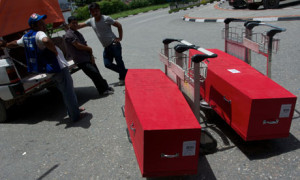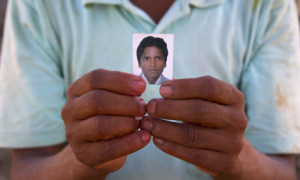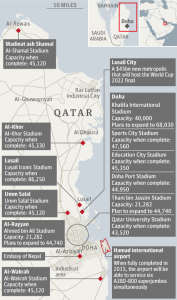At 16, Ganesh Got a Job in Qatar – Two Months Later He Was Dead
IN FOCUS, 30 Sep 2013
Pete Pattisson in Kathmandu and Doha – The Guardian
Nepalese workers go to Qatar to find a way out of poverty. Instead, many are trapped into 12-hour days and nights in overcrowded, filthy camps. Some never make it home alive.

The coffins of two Nepalese workers killed in Qatar, at Kathmandu airport before delivery to their families. Photograph: Peter Pattisson/guardian.co.uk
Amid the urgent bustle of Kathmandu airport, you can see one of globalisation’s most bitter sights. At the departure gate, hopeful parents bid tearful farewells to their garlanded sons as they join the hundreds of thousands of Nepalese heading overseas for work. At the other end of the terminal, among the stream of passengers emerging through arrivals, the coffins of migrant workers are wheeled out on luggage trolleys to be collected by families. Some relatives are stoic, others wail and writhe on the floor. On average, three or four bodies arrive home every day.
These are the big losers of scandalous abuse and exploitation of some of the poorest, most disenfranchised people on the planet: the workers who leave Nepal for the Middle East every year.
Ganesh Bishwakarma was one such worker. For Ganesh, Qatar was an oasis in the desert, a promised land where he could work his way out of the acute poverty that had trapped his family in Nepal’s rural Dang district for generations. Like many others in his village he had met the recruitment agents who promised well paid work and the opportunity to provide for his family. He left pledging to come back and build his mother a beautiful house.
He did return – after only two months and in a coffin. He was 16.
“We didn’t think he would die like this,” said his grandmother, Motikala. “We didn’t think we would be crying like this.”
It was late at night when the ambulance carrying Ganesh’s body pulled up outside his family’s small mud house. The wailing of his friends and neighbours started long before his coffin was unloaded and carried back home by his shocked and grieving family. All night his family crouched around the child’s coffin. As dawn broke, they said their final farewells and lit his funeral pyre.
At 16, Ganesh was too young to have legally migrated for work, but that did not stop a local recruitment broker arranging a fake passport stating he was 20. The broker charged an extortionate fee for a cleaning job in Qatar – far in excess of the legal limit set by the Nepalese government – leaving the boy and his family with a 150,000-rupee (£940) recruitment debt that he promised to pay back at an interest rate of 36%.
Every year, almost 400,000 Nepalese men and women leave their towns and villages for jobs overseas. More than 100,000 head to Qatar, where a booming construction industry and insatiable appetite for cheap labour has been fuelled by its successful bid to host the 2022 World Cup, celebrated by the Emir Sheikh Hamad bin Khalifa al-Thani and his wife, pictured below. Yet instead of the salaries and prospects they have been promised, many of these workers are led into a web of exploitation, corruption and deceit and, increasingly, slavery and death.
For many of these migrants, their fate is sealed before they have left Nepal. “[Nepalese migrant workers] go without asking questions,” said Nilambar Badal, director of the Migrants’ Centre in Nepal, which advises migrants of the risks of working overseas. “And so every penny is extracted from them.”
While construction of the stadiums is yet to start, Qatar is already a giant building site as it prepares for the World Cup. Construction sites can range from vast chasms crawling with thousands of workers, to a handful of men building a villa. What doesn’t change is the relentless heat and humidity. Workers on most sites toil away in pale blue boilersuits stained dark by their sweat. They wrap themselves up, even draping their faces in cloth to shield them from the sun. Often only their eyes are visible.
Ten miles from the centre of Doha, workers are toiling under a searing sun on the Lusail City development. By 2022, this huge building site will be Qatar’s gleaming new metropolis and a centrepiece of Qatar’s World Cup tournament. Yet there is mounting evidence to suggest it is being built in part on the forced labour of men who find themselves powerless to leave – their wages retained to stop them running away, their passports confiscated and deprived of the ID cards they need to move around freely without fear of arrest.
Some workers at Lusail City say they have not been paid for months and can only watch as the interest mounts on their debts in Nepal. One group finally took strike action to demand their wages, a drastic step given that the authorities can simply expel them to penury and shame back at home for the most minor infraction.
“The situation has become so bad that we have had to go on strike three or four times to demand our salary,” said SBD, a Nepalese migrant who works on Lusail’s marina. “Once we stole the keys from the buses which take us to work so they could not force us to go. We’ve gone to the police, but they refused to help us.”
An hour’s drive away, a vast dusty industrial zone west of Doha is home to tens of thousands of migrant workers. Temperatures can reach up to 50C, with labourers working up to 12 hours a day, yet the men who have been put to work for a sub-contractor claim they are not supplied with drinking water.
At night they return to filthy and overcrowded accommodation in the Sanaya industrial centre, where the stench of raw sewage is overpowering and workers allege 600 men share two kitchens. “The kitchens are infested with mosquitoes, cockroaches and bugs,” said KBB, one of the camp’s residents. “Flies are sitting on the food. People are getting sick.”
The appalling toll on migrant labourers building the infrastructure for the World Cup is reflected right across Qatar’s construction sector.
In a tiny room behind the Nepalese embassy, the Guardian found dozens of migrant workers seeking rescue and redress from their employers. “When my two-year contract finished, I asked my employer to let me go home. He kept promising to issue me with an exit permit and send me home, but he never did,” said Bir Bahadur Lama, 25, who has been trying to return to Nepal for a year. “Last year my employer sold me to another man, but when he realised I was an undocumented worker, he fired me. My only option now is to turn myself in to the police, and hope that they’ll deport me.”
One large group sought refuge after their employer had allegedly paid no wages for months at a time. They said he was now refusing to issue the exit permits they needed to return home.
“We do not want to leave our money behind, but we are risking our lives by staying here. It is not worth it,” said Ramesh Kumar Bishwakarma, 32, who has not been paid for 10 months. “Just give us a ticket and our passports. We want to leave as fast as possible.”
For an increasing number of migrants, their only way out of Qatar is in a coffin. Mortality rates among Nepalese workers have risen over the past few years. Nepal’s foreign employment promotion board (FEPB) estimates that 726 migrants died overseas in 2012, an 11% increase on the previous year.
Migrant rights group Pravasi Nepali Co-ordination Committee (PNCC) said the real number of deaths was likely to be double this as the FEPB’s figures include only those where a relative claimed compensation or insurance money. It put the death toll closer to 1,300. “The number of deaths among Nepalese migrants is much higher than other south Asian countries,” said Mahendra Pandey, the chair of PNCC. “Most Nepalese work in construction, but they are not experienced at this type of work, which is much more risky than other jobs. They also often find they are not being paid a good salary which led some to commit suicide.”
The most common cause of death given on forms is some form of heart failure. There is confusion over why so many apparently healthy young men are dying of cardiac arrest – so much so that these deaths are now commonly referred to as “sudden death syndrome”.
“These workers who are dying are young, but heart attacks are not a common cause of death among young people,” said Dr Prakash Raj Regmi, president of the Nepal Heart Foundation, who points to the appalling working and living conditions these workers endure as a possible cause, saying: “These men have poor eating habits, high levels of mental stress and work long hours in extreme conditions.”
Ganesh’s family was told the boy died of a cardiac arrest weeks after he arrived in Qatar. It is something the family finds hard to accept. “This son of mine was strong. He didn’t even have a cough,” said his father, Tilak Bahadur. “He went abroad and died unexpectedly. Was it the climate or something else?”

Tilak Bahadur Bishwakarma holds a photo of his son, Ganesh, 16, who died in Qatar from a cardiac arrest, six weeks after leaving Nepal. Photograph: Peter Pattisson/guardian.co.uk
The Nepalese government seems unwilling to act against mounting evidence of the labour abuses faced by thousands of its citizens. It blames the recruitment agencies, which it accuses of conning vulnerable workers into bogus contracts and inflated recruitment fees.
“We know about these problems, and we have taken certain measures against the responsible agencies,” said Divas Acharya, director of the department of foreign employment in Nepal. “We are trying to do more, but we are short of staff and resources.”
For Ganesh’s family, the hope they felt two months ago as their boy left for Qatar has turned into uncertainty and despair. As the flames from the funeral pyre started to die down, his father’s thoughts turned to the debt that Ganesh had left behind. Despite his son’s hopes of returning home a rich man, the family never received a rupee from Qatar.
“I don’t know how I am going to pay back the loan we took out to pay for my son’s job. It is on my mind the whole time. I know the lender won’t spare me,” he said. “I don’t ever want to hear the name of Qatar again.”
From safety to serfdom
For most of the thousands of migrant workers who flock to the Middle East, their problems originate at home, with unscrupulous recruitment agents who often impose high fees for finding them a job and make false promises about salaries and contract terms.
The more ruthless will fake documents, including health certificates, to make their “clients” seem fitter for work than they really are. The poorer migrants will usually have to borrow money – often at steep rates – from moneylenders or other people in their village to pay their way.
Once in Qatar, the kafala system binds the worker to a single employer. Workers have little scope to complain about malpractice, such as confiscation of passport, late payment of wages and failure to issue ID cards, because the employer knows his labourers depend on him. Kafala requires employers to report workers who quit without permission for “absconding”, an offence leading to their detention and deportation. It also requires workers to secure exit permits from their employer before they can go abroad.
“We can’t run away and we can’t change company,” said an electrician working at the new international airport. “If we run away the police may catch us – we are afraid of them. We will become illegal.”
According to the International Labour Organisation, forced labour is “all work which is exacted from someone under the menace of any penalty and for which the said person has not offered himself voluntarily”.
The ILO’s checklist specifies a range of conditions that are the hallmarks of forced labour. The Nepalese allegations tick many of these boxes, including physical violence, exclusion from community, removal of rights and privileges, worsening of working conditions, the withholding of wages, retention of identity documents, and induced indebtedness.
Human Rights Watch said: “The sponsorship law prohibits migrant workers from changing jobs without their employer’s consent; even when employers fail to pay competitive wages, provide decent conditions, or meet the conditions of the employment contract, workers cannot simply change jobs.”
Go to Original – theguardian.com
DISCLAIMER: The statements, views and opinions expressed in pieces republished here are solely those of the authors and do not necessarily represent those of TMS. In accordance with title 17 U.S.C. section 107, this material is distributed without profit to those who have expressed a prior interest in receiving the included information for research and educational purposes. TMS has no affiliation whatsoever with the originator of this article nor is TMS endorsed or sponsored by the originator. “GO TO ORIGINAL” links are provided as a convenience to our readers and allow for verification of authenticity. However, as originating pages are often updated by their originating host sites, the versions posted may not match the versions our readers view when clicking the “GO TO ORIGINAL” links. This site contains copyrighted material the use of which has not always been specifically authorized by the copyright owner. We are making such material available in our efforts to advance understanding of environmental, political, human rights, economic, democracy, scientific, and social justice issues, etc. We believe this constitutes a ‘fair use’ of any such copyrighted material as provided for in section 107 of the US Copyright Law. In accordance with Title 17 U.S.C. Section 107, the material on this site is distributed without profit to those who have expressed a prior interest in receiving the included information for research and educational purposes. For more information go to: http://www.law.cornell.edu/uscode/17/107.shtml. If you wish to use copyrighted material from this site for purposes of your own that go beyond ‘fair use’, you must obtain permission from the copyright owner.
